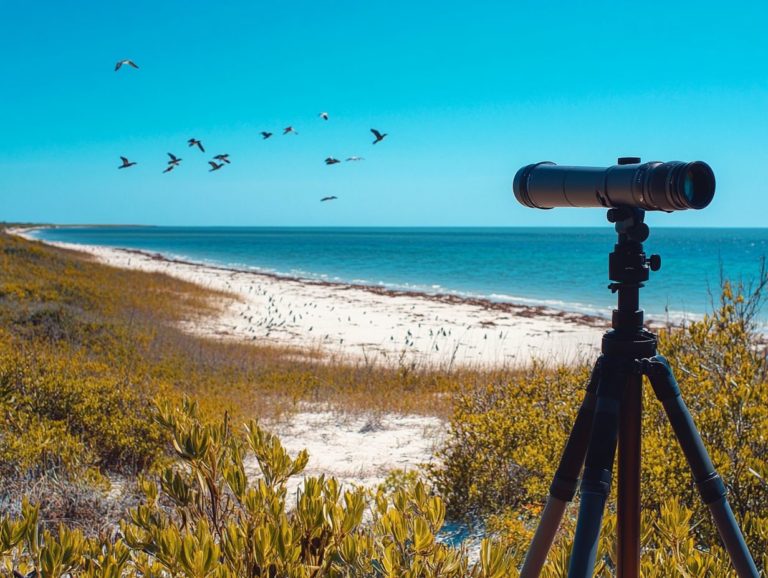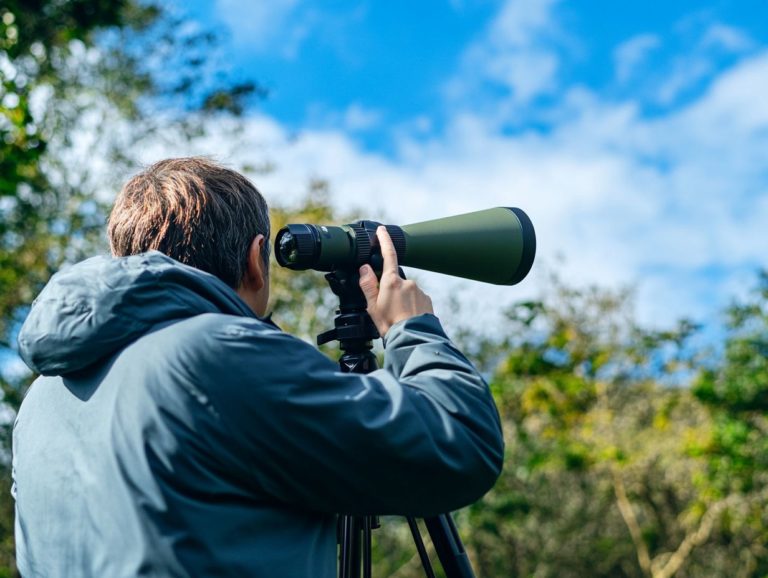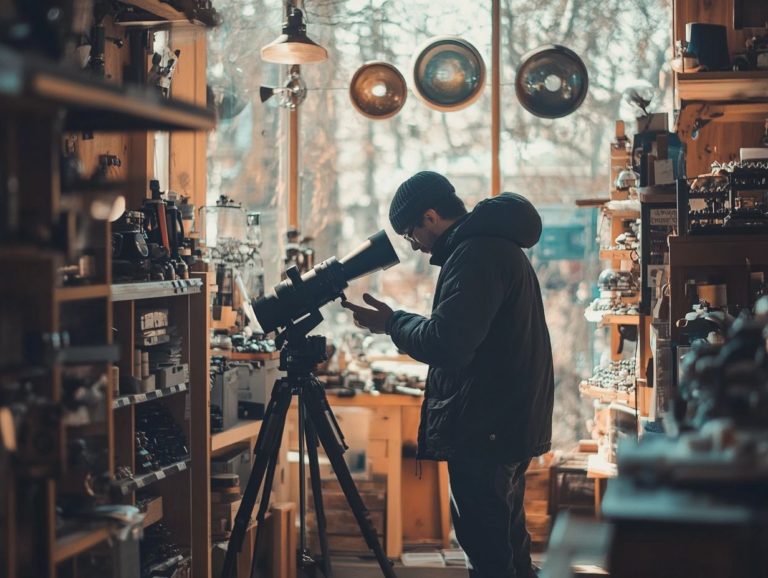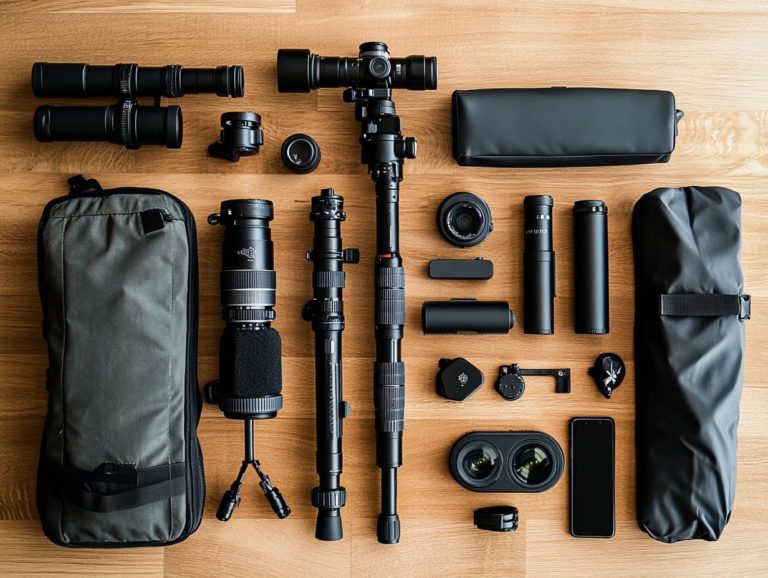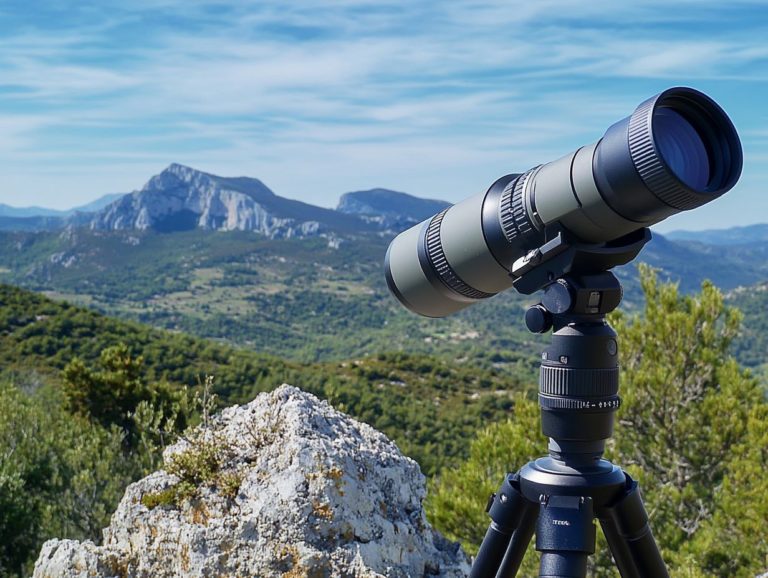Spotting Scope Reviews: Entry-Level Models for Newbies
Curious about spotting scopes and how they can elevate your outdoor life experience? Whether you re an aspiring birdwatcher, a budding wildlife photographer, or simply someone who revels in exploring nature, selecting the right entry-level spotting scope can truly enhance your adventures.
This guide will illuminate what spotting scopes are, how they differ from telescopes, and why they re essential for beginners. You ll find details about manufacturers, product specifications, reviews of top models, essential usage tips, and answers to frequently asked questions.
Jump in now to find the ideal spotting scope that will transform your adventures!
Contents
- Key Takeaways:
- 1. What Is a Spotting Scope and How Is It Different from a Telescope?
- 2. Why Should You Consider an Entry-Level Spotting Scope?
- 3. Factors to Consider When Choosing an Entry-Level Spotting Scope
- 4. Top 5 Entry-Level Spotting Scopes for Newbies
- 5. Features and Specifications Comparison of the Top 5 Entry-Level Spotting Scopes
- 6. Pros and Cons of Each Entry-Level Spotting Scope
- 7. Tips for Using an Entry-Level Spotting Scope
- 8. How to Care for Your Entry-Level Spotting Scope
- 9. Frequently Asked Questions about Entry-Level Spotting Scopes
- Bridging Question: What Are the Advantages of Upgrading to a Higher-End Spotting Scope?
- Frequently Asked Questions
- What is a spotting scope and why is it useful for beginners?
- What are some key features to consider when looking for an entry-level spotting scope?
- What is the difference between straight and angled spotting scopes?
- Are entry-level spotting scopes suitable for different weather conditions?
- Can I use an entry-level spotting scope for hunting?
- Why are entry-level spotting scopes a good choice for newbies?
Key Takeaways:
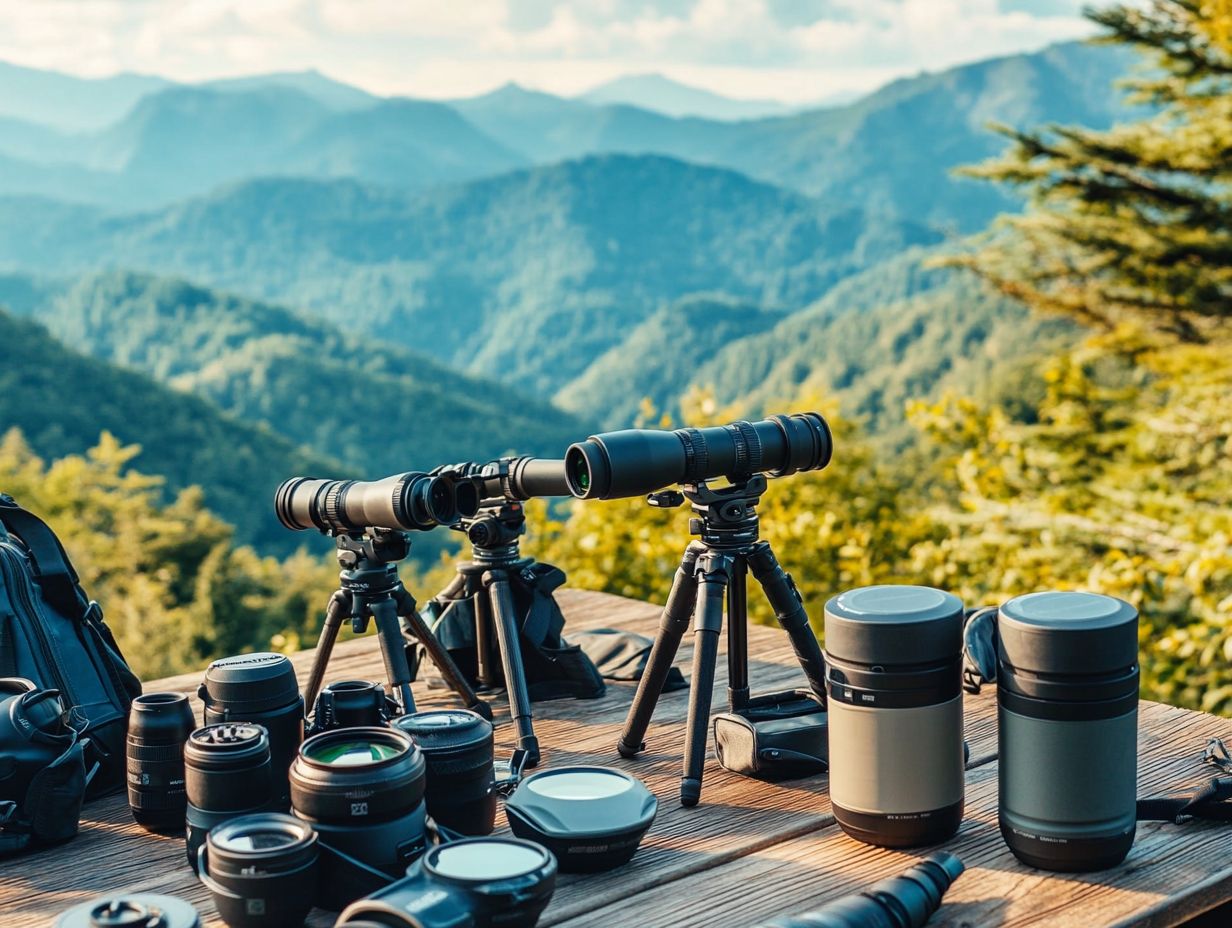
Entry-level spotting scopes offer beginners an affordable yet quality way to experience nature.
Consider key features like zoom and lens size when selecting your scope for the best experience.
Taking care of your scope will maximize your outdoor adventures!
1. What Is a Spotting Scope and How Is It Different from a Telescope?
A spotting scope is your go-to optical device for embracing the great outdoors. It offers enhanced optical and mechanical performance compared to a traditional telescope, making it perfect for birdwatching, wildlife observation, and target shooting.
These scopes are meticulously designed to deliver superior image quality, optical resolution, and brightness scores, catering to those who seek precision and clarity in various outdoor environments.
You ll find that spotting scopes typically boast a compact design and lightweight construction, such as the Nikon Monarch or Vortex Razor HD. This allows you to transport them effortlessly and adjust your view with ease. The size of the lens at the front is crucial; it significantly influences light-gathering capabilities, which directly affects image brightness during those magical dawn and dusk moments.
While they may have a narrower field of view compared to telescopes, this feature enhances your ability to make detailed observations at long distances, making them ideal for wildlife-watching scopes and hunting.
Thanks to their versatility, spotting scopes are particularly well-suited for activities like hunting, hiking, and attending sporting events, delivering exceptional performance and reliability in a wide range of settings.
2. Why Should You Consider an Entry-Level Spotting Scope?
Considering an entry-level spotting scope opens up a world of high-quality optics for you, including models like Athlon Cronus G2 and Maven S.1A. For families, spotting scopes for kids make it an accessible choice if you’re interested in wildlife-watching and outdoor activities without straining your budget.
These scopes blend affordability with impressive optical clarity, allowing you to relish crisp, detailed images without the steep price tag often tied to high-end models. Their user-friendly designs ensure that even if you’re new to this, you can set up quickly and start exploring your surroundings with ease.
While higher-end scopes may boast advanced features and superior materials, entry-level options often deliver more than enough performance for beginners, striking an ideal balance between cost and functionality. For those looking to make an informed choice, spotting scope selection factors can enhance this accessibility, enabling you and a new generation of enthusiasts to connect with nature, enriching your experience and igniting a lifelong passion for outdoor life exploration.
Ready to start your adventure? Let s find the right spotting scope for you today!
3. Factors to Consider When Choosing an Entry-Level Spotting Scope
When selecting an entry-level spotting scope, consider how well the scope works, image quality, low-light performance, and warranty details. These elements are essential for ensuring a satisfying purchase experience.
Also, think about optical resolution. It affects the clarity you’ll see through the scope. If you re a wildlife enthusiast, knowing your intended use can significantly influence your choice. For example, comparing full-size spotting scopes with mid-size scopes is important. A scope for observing distant animals will require different features than one designed for casual birdwatching.
Evaluating the scope against various testing criteria will help you assess its real-world performance under different lighting conditions. Budget considerations will shape your decision-making process, as you’ll find a range of options across various price points. Lastly, user feedback is invaluable; it offers insights into others’ experiences, enabling you to make an informed choice.
4. Top 5 Entry-Level Spotting Scopes for Newbies
For those new to the world of spotting scopes, the following five models are standout performers. They boast exceptional optical clarity, user-friendly features, and solid performance. To enhance your experience, consider these tips for beginners, making them ideal entry-level picks for outdoor enthusiasts like yourself.
These models cater to a range of preferences and budgets. This ensures you can find the perfect fit for your adventure needs. With a strong emphasis on ease of use and reliable optics, these scopes will elevate your viewing experience, whether you’re birdwatching, stargazing, or observing wildlife in their natural habitat.
Each option showcases a blend of robust construction and innovative technology, designed to deliver impressive images even in challenging light conditions. Providing essential specifications like objective lens size which affects how much light the scope can gather field of view, and low-light performance will help you make an informed decision, enhancing your outdoor pursuits. Don t miss out on these fantastic models; they are perfect for your next adventure!
5. Features and Specifications Comparison of the Top 5 Entry-Level Spotting Scopes
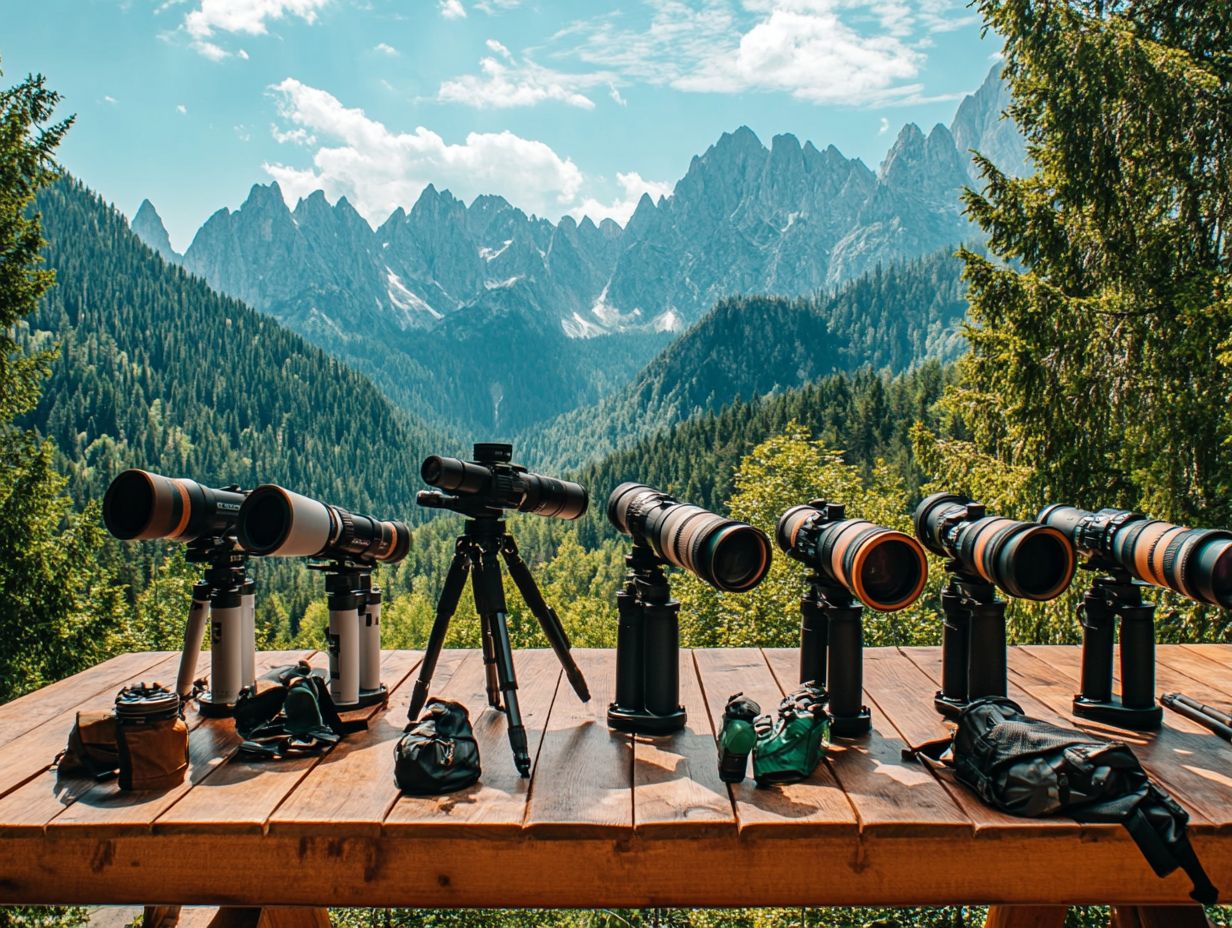
The image above compares the key specifications of each scope. A comparative analysis reveals key features and specifications that distinguish these models, enabling you to make informed decisions based on optical performance and user feedback.
By exploring aspects such as optical resolution, brightness scores, and mechanical performance, you can determine which scope best aligns with your needs, ensuring you understand the price value as well. The importance of these features cannot be overstated. Optical resolution directly influences clarity during viewing, while brightness scores significantly impact usability in various lighting conditions.
Mechanical performance is equally crucial for overall reliability and ease of handling. As you evaluate these critical elements, your overall user experience and satisfaction are likely to improve, allowing you to tailor your selection process to suit your individual requirements.
6. Pros and Cons of Each Entry-Level Spotting Scope
Evaluating the pros and cons of each entry-level spotting scope provides valuable insights into their strengths and weaknesses, including their mechanical performance. This helps you understand what to expect in terms of optical clarity and overall performance.
By diving deeper into the features, you can assess how these models differ in price. They offer a range of options that cater to various budgets. User feedback often sheds light on key aspects like optical performance. Clarity, brightness, and color accuracy are essential, particularly in models like Leupold SX-5 or Meopta MeoStar.
Some users point out that while certain models shine in these areas, they may fall short in mechanical durability, raising concerns about long-term use. External features like tripod mounts, portability, and ease of setup significantly influence your experience as you seek to make the most of your outdoor adventures.
To summarize, weigh the pros and cons before making a purchase to ensure you choose the right spotting scope for your needs.
7. Tips for Using an Entry-Level Spotting Scope
Maximizing the effectiveness of your entry-level spotting scope hinges on understanding essential tips that can elevate optical clarity and enhance your overall viewing experience, particularly when using eyepiece optics.
One crucial aspect to consider is the focus adjustment. Take your time to gently turn the focus wheel until the image sharpens to perfection. In low-light conditions, employing the scope’s zoom options with care can dramatically improve visibility. Don t overlook regular maintenance clean the lenses with a soft cloth and store the scope in a protective case to ensure its longevity.
Interpreting user feedback can provide valuable insights into the best adjustments, making it worthwhile to explore reviews and engage in discussions with fellow enthusiasts to refine your techniques.
8. How to Care for Your Entry-Level Spotting Scope
Proper care for your entry-level spotting scope is essential for maintaining its optical performance and extending its lifespan, allowing you to fully appreciate your investment.
To achieve this, make it a habit to clean the lenses regularly with a soft microfiber cloth and an appropriate lens cleaner to prevent blurry images. By making this simple routine a habit, you ll keep your images clear and vibrant!
Additionally, routinely checking for any loose components can help you avoid potential mechanical issues, enhancing the longevity of your scope.
As you prioritize these maintenance tasks, it s wise to keep your warranty information at hand, as it often provides invaluable guidance on servicing and may cover necessary repairs, ensuring your investment remains safeguarded for years to come while understanding the street price of replacements.
9. Frequently Asked Questions about Entry-Level Spotting Scopes
Addressing frequently asked questions about entry-level spotting scopes can provide you with essential information, easing common concerns and boosting your confidence in making a purchase.
By looking into various aspects like optical performance, you can gain a clearer understanding of how image clarity and brightness can significantly enhance your outdoor experiences. Think carefully about magnification, durability, and weight when choosing your model each of which plays a pivotal role in different activities, whether you re birdwatching or hunting.
Don t overlook warranty specifics, as they dictate your service options and the long-term reliability of your purchase. A thorough set of answers helps you navigate the complexities of these devices with ease, enabling you to make informed choices that perfectly align with your needs.
Bridging Question: What Are the Advantages of Upgrading to a Higher-End Spotting Scope?
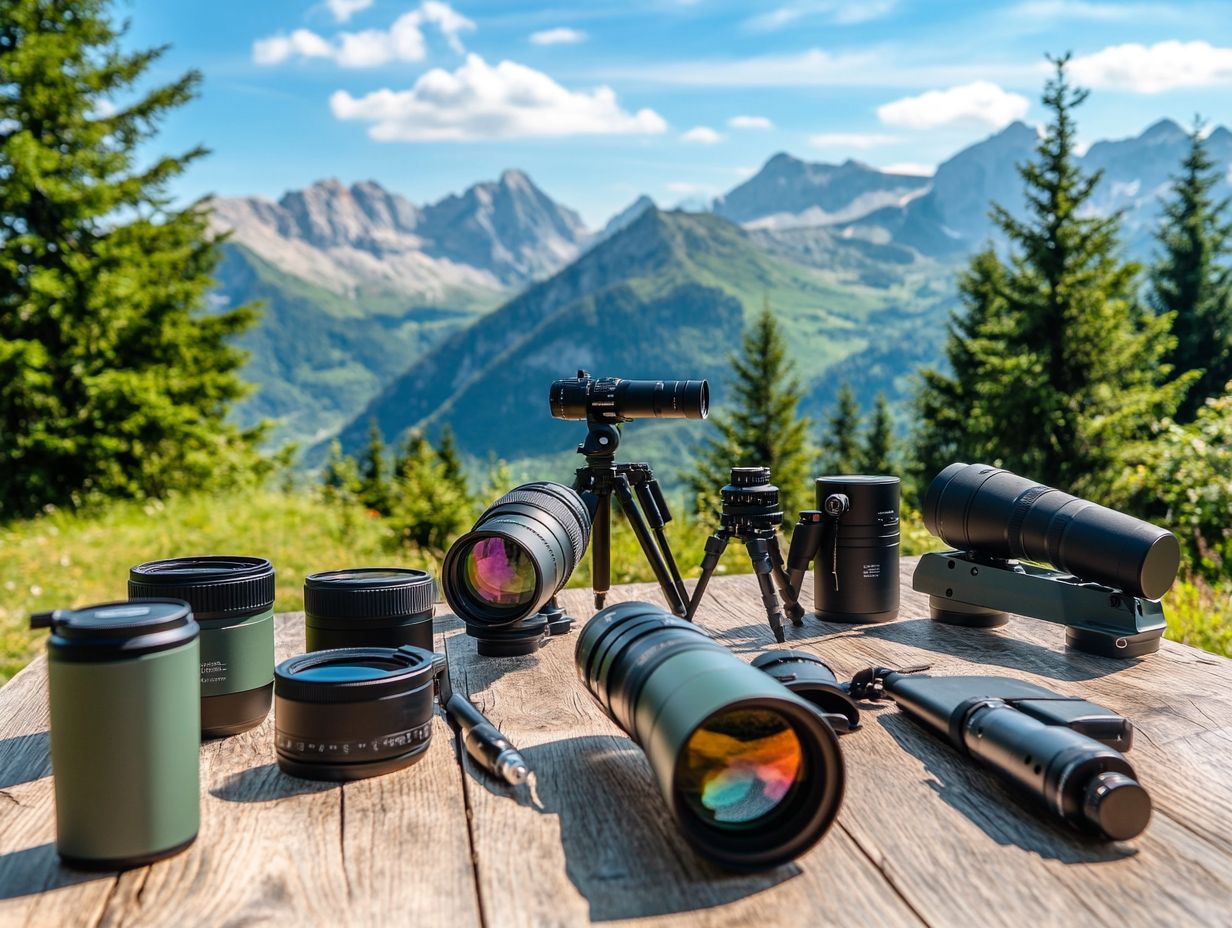
Upgrading to a higher-end spotting scope provides you with substantial advantages, especially in optical performance, image quality, and overall user satisfaction. It s an investment that serious enthusiasts find worthwhile.
You ll likely notice impressive enhancements in optical resolution, granting you clearer and more detailed images, even from a distance. The low-light performance of these premium scopes is another area where you can expect remarkable improvements, offering bright, sharp views during the magical hours of dawn and dusk when wildlife is most active.
Moreover, the use of premium glass significantly minimizes aberrations, leading to a more enjoyable viewing experience. Many enthusiasts share how these upgrades transform their outdoor adventures, enabling them to see details they never thought possible, ultimately deepening their passion for observing nature.
What Are the Different Types of Spotting Scopes?
Spotting scopes come in a variety of types, such as compact spotting scopes, mid-size scopes, and full-size spotting scopes, each designed to cater to your specific outdoor needs and preferences.
Compact spotting scopes are lightweight and portable, perfect for hikers or birdwatchers who want to travel light while still enjoying impressive optical performance. On the other hand, mid-size scopes strike a balance between portability and enhanced optical capabilities. They are suitable for birding and casual wildlife observation.
Full-size spotting scopes take things up a notch, offering superior magnification and larger objective lenses that boost clarity and detail ideal for target shooting or serious wildlife enthusiasts.
While compact scopes are a breeze to carry, their smaller lenses can sometimes limit light transmission. Mid-size models provide a bit more heft but remain manageable for most outings. As for full-size scopes, they deliver exceptional views, yet their weight can make them cumbersome for longer treks.
What Are the Primary Uses of a Spotting Scope?
The primary uses of a spotting scope extend across a range of outdoor activities, from wildlife watching to precision target shooting, highlighting their impressive versatility.
This remarkable adaptability makes them essential tools for birdwatching. You can observe avian species at astonishing distances without disturbing their natural habitat. In hunting, the optical clarity becomes crucial for identifying game in low-light conditions. Features like variable magnification allow you to zoom in or out according to the surrounding terrain.
For competitive shooting, these scopes provide the stability and accuracy that enable you to fine-tune your aim with precision. Thanks to advancements in optical performance such as enhanced light transmission and anti-reflective coatings alongside robust mechanical features like durable housing and smooth focusing mechanisms, spotting scopes elevate your experience and effectiveness across these diverse pursuits.
What Are the Key Features to Look for in an Entry-Level Spotting Scope?
When evaluating an entry-level spotting scope, you should prioritize several key features to ensure your complete satisfaction. Look for optical clarity, mechanical performance, and budget considerations that align with your expectations.
The size of the objective lens is crucial, as it directly impacts the amount of light gathered. This enhancement significantly improves brightness and clarity, particularly in low-light conditions.
You should also consider the field of view, which shapes your overall experience by determining how much of the landscape you can see through the eyepiece. Don’t overlook the quality of the eyepiece optics superior optics will provide you with better image sharpness and color fidelity.
Understanding these key features will empower you to choose the perfect scope for your adventures, ensuring exceptional value and performance tailored to your specific needs.
How Can You Tell If a Spotting Scope Is High-Quality?
Determining if a spotting scope is of high quality involves evaluating its optical performance, focusing on clarity, resolution, and the rigorous testing criteria that industry experts use to assess various models.
Beyond these essential factors, consider external features such as build quality, weight, and weather resistance. These elements significantly impact usability across different environments. A reliable spotting scope needs to be robustly constructed to endure harsh conditions while remaining lightweight for easy transport.
Delving into user reviews and comparison tests can yield invaluable insights into real-world performance, aiding you in making informed decisions. Ultimately, the perfect model marries exceptional optical clarity with practical features, ensuring you maximize your outdoor observation experiences.
Ready to explore the outdoors? Find the perfect spotting scope today!
What Are the Common Mistakes to Avoid When Using an Entry-Level Spotting Scope?
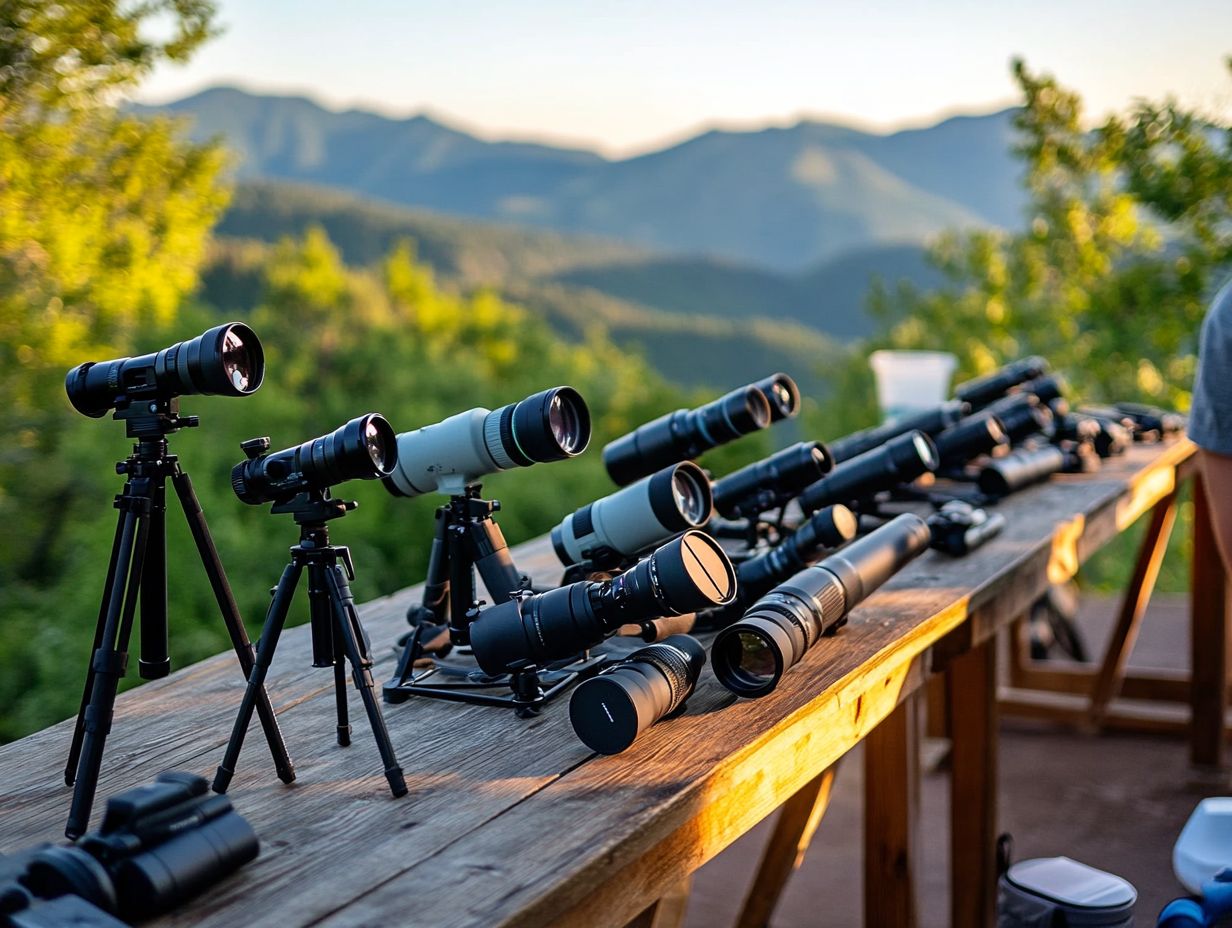
Avoiding common mistakes with an entry-level spotting scope can significantly enhance your experience. This ensures a clear view during your outdoor adventures.
New users often overlook essential aspects. This can lead to frustrating encounters, such as incorrect focusing or inadequate stabilization, which causes shaky views.
Some individuals neglect the maintenance of their equipment. This ultimately leads to diminished performance over time.
To sidestep these pitfalls, it s vital to practice proper focusing techniques. Adjust the eyepiece and use the focus knob with a gentle touch.
Utilizing a sturdy tripod can dramatically enhance stability. Regular cleaning and careful storage will help maintain the scope s condition.
By adopting these solutions, you can undoubtedly elevate your observational experience to new heights.
Frequently Asked Questions
What is a spotting scope and why is it useful for beginners?
A spotting scope is a portable optical instrument used for observing distant objects. It’s essentially a compact telescope designed for terrestrial use.
It is useful for beginners because it provides a clear and magnified view, making it easier to observe and identify wildlife, birds, and other outdoor activities.
What are some key features to consider when looking for an entry-level spotting scope?
Key features to consider include magnification power, objective lens diameter, and field of view.
Magnification power determines how much an image is enlarged, while objective lens diameter affects light-gathering capability.
A wider field of view allows for a larger viewing area and makes tracking moving objects easier.
What is the difference between straight and angled spotting scopes?
Straight spotting scopes have a straight barrel design, which is more convenient for viewing objects at eye level.
Angled spotting scopes have a 45-degree angle between the eyepiece and the barrel, making them more comfortable for looking upwards, such as when birdwatching or stargazing.
Are entry-level spotting scopes suitable for different weather conditions?
Most entry-level spotting scopes are designed to be weather-resistant but not completely waterproof.
They can withstand light rain or mist, but should not be submerged in water. For extreme weather conditions, it’s recommended to invest in a more advanced and durable model.
Can I use an entry-level spotting scope for hunting?
Yes, entry-level spotting scopes can be used for hunting, especially for beginners. They provide a clear and magnified view of distant objects, making it easier to spot and track animals.
However, for more advanced hunting needs, it is advisable to upgrade to a higher quality and more specialized scope.
Why are entry-level spotting scopes a good choice for newbies?
Understanding marketing terms helps you navigate consumer information effectively for your purchase decision. For optimal performance evaluation, check the tripod mount options available with various optical brands.
Performing a comparative analysis based on street price and retail pricing will help you find the best value.
Don’t forget to look into warranty details and user feedback regarding different manufacturers.
Evaluate brightness scores and low-light performance as part of your testing criteria. Focus on features like the objective lens and reticle eyepiece to enhance your experience.
Entry-level spotting scopes are perfect for newcomers eager to explore nature! They offer great optical performance and are easy to carry around, making them an ideal first choice for those looking to read the beginner’s guide to spotting scopes.

